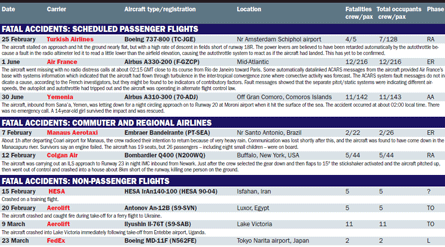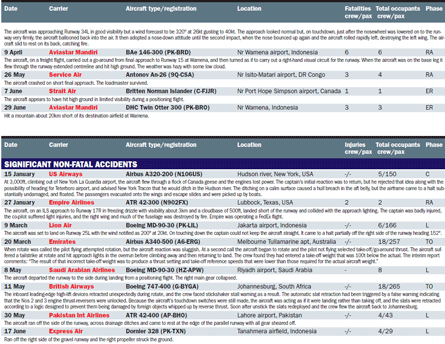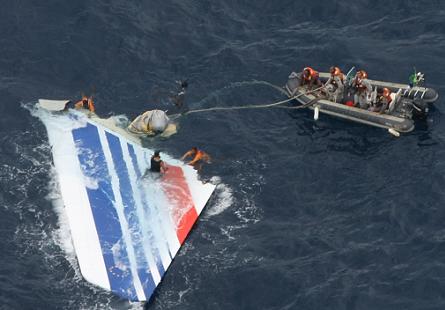Global airline fatal accident numbers for the first six months of 2009 provide further confirmation of a now-established trend: airline safety has stopped improving and, at best, has flattened out.
The number of fatal airline accidents between 1 January and 30 June 2009, at 13, is slightly below the average for the first half of each year in the past 10 years, which stands at 14.8.
The same comparison for the number of fatalities is less good: there were 499 to 30 June this year against an average of 344 for the first six months of each year in the last decade.
But a median line for fatal accident numbers drawn across the graph opposite would be flat, and even taking into account the growth in traffic between 2001 and 2007, the rates would not be improving at a statistically significant rate. International Civil Aviation Organisation provisional figures confirm this.
|
|
|---|
© Rex FeaturesAir France 447's fin was the only large piece of wreckage to be recovered |
Unless there is a dramatic improvement in airline safety performance between now and the end of 2010, then 2001-10 will become the first decade since the Second World War when global airline accident rates did not show improvement.
The number of fatalities to 30 June is the highest since 2002, mainly because two accidents involved widebodies (see accident listings P38), and between them they accounted for 381 of the total 499 deaths.
All on board the Air France Airbus A330-200 were killed, and there was only a single survivor from the Yemenia Airbus A310-300 crash.
Meanwhile, the Air France incident represents the first fatal accident involving one of the major world carriers flying a Western-built widebody since an American Airlines A300-600 crashed in Belle Harbor, New York in November 2001.
 |
|---|
Larger version of the glossary |
The Air France loss has caused more speculation inside and outside the industry than any other serious accident for years, but no hint as to the cause has yet emerged.
Speculation has probably been fuelled by the fact that, although the crew did not report any problem, the aircraft communicating, reporting and addressing system (ACARS) had automatically datalinked some systems information to the carrier's maintenance base just before the A330 went missing, providing evidence of a disparity between the values sent by separate airspeed sensors to the air data computers.
According to the French investigation agency, BEA, this information on its own does not provide any causal clues, but BEA says it might turn out to be a factor in whatever occurred.
The main concern now is that the flight recorders are in deep water in a region of the Atlantic where the terrain on the oceanic floor is mountainous, which will make finding them a formidable task.
 |
|---|
SOURCE: Flight International |
The issue of the human factors associated with operating highly automated aircraft is likely to move up the agenda once more following the February crash of a Turkish Airlines Boeing 737-800 on approach to Amsterdam Schiphol airport in February.
It stalled and hit the ground at a high rate of descent, and early statements from the Dutch investigator indicate that a faulty radio altimeter may have caused the autothrottles to reduce power to idle early in the approach by incorrectly indicating the aircraft's height was 8ft (2.4m) below airfield elevation.
 |
|---|
© Rex FeaturesThe FedEx Boeing MD-11 freighter suffered a disastrous landing following a fairly stable approach |
As a result, the investigators believe, the system logic reacted as if the aircraft was touching down and retarded the power levers, but the pilots did not notice the movement or the speed loss until too late.
On the other hand, highly automated - including fly-by-wire - aircraft still often survive extremely taxing situations, and both the aircraft and the crew emerge smelling of roses.
 |
|---|
Larger version of the table |
The US Airways Airbus A320 successful ditching in the Hudson River, New York early this year was one such event.
The crew, having lost all engine power to a multiple birdstrike, made sound decisions, executed them well, and the aircraft floated perfectly despite damage to the underside of the rear hull.
 | |
|---|---|
Larger version of table |
Source: Flight International

















